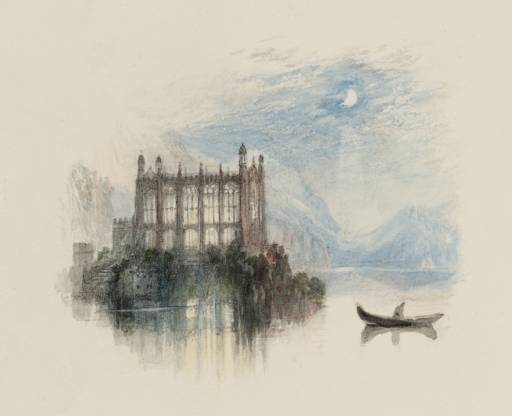Joseph Mallord William Turner St. Herbert's Chapel, for Rogers's 'Poems' c.1830-2
Joseph Mallord William Turner,
St. Herbert's Chapel, for Rogers's 'Poems'
c.1830-2
Joseph Mallord William Turner 1775–1851
St. Herbert’s Chapel, for Rogers’s ‘Poems’ circa 1830–2
D27697
Turner Bequest CCLXXX 180
Turner Bequest CCLXXX 180
Pencil and watercolour, approximately 110 x 125 mm on white wove paper, 240 x 305 mm
Inscribed in pencil ‘x’ at top of sheet
Stamped in black ‘CCLXXX 180’ bottom right
Inscribed in pencil ‘x’ at top of sheet
Stamped in black ‘CCLXXX 180’ bottom right
Accepted by the nation as part of the Turner Bequest 1856
Exhibition history
1904
National Gallery, London, various dates to at least 1904 (238).
1936
Four Screens, British Museum, London, July 1936–February 1937 (no catalogue but numbered 10).
1971
Watercolours by J.M.W. Turner (1778 [sic] –1851): Lent by the Trustees of the British Museum, Abbot Hall Art Gallery, Kendal, January–March 1971 (2).
1982
The Lake District Discovered 1810–1850: The Artists, The Tourists, and Wordsworth, Grasmere and Wordsworth Museum, Grasmere, May–October 1982 (87).
1993
Turner’s Vignettes, Tate Gallery, London, September 1993–February 1994 (14, reproduced).
1998
Moonlight and Firelight: Watercolours from the Turner Bequest, Tate Gallery, London, July–November 1998 (no catalogue).
References
1903
E.T. Cook and Alexander Wedderburn (eds.), Library Edition: The Works of John Ruskin: Volume I: Early Prose Writings 1834–1843, London 1903, pp.233, 244.
1904
E.T. Cook and Alexander Wedderburn (eds.), Library Edition: The Works of John Ruskin: Volume XIII: Turner: The Harbours of England; Catalogues and Notes, London 1904, pp.380–1.
1906
E.T. Cook and Alexander Wedderburn (eds.), Library Edition: The Works of John Ruskin: Volume XXI: The Ruskin Art Collection at Oxford, London 1906, p.214.
1909
A.J. Finberg, A Complete Inventory of the Drawings in the Turner Bequest, London 1909, vol.II, p.902, as ‘St. Hubert’s Isle, Derwentwater’.
1966
Adele Holcomb, ‘J.M.W. Turner’s Illustrations to the Poets’, unpublished Ph.D thesis, University of California, Los Angeles 1966, pp.86, 100.
1971
Watercolours by J.M.W. Turner (1778 [sic] –1851): Lent by the Trustees of the British Museum, exhibition catalogue, Abbot Hall Art Gallery, Kendal 1971, pp.[4–5] no.2.
1979
Andrew Wilton, The Life and Work of J.M.W. Turner, Fribourg 1979, p.441 no.1183, reproduced.
1983
Peter Bicknell and Robert Woof, The Lake District Discovered 1810–1850: The Artists, The Tourists, and Wordsworth, exhibition catalogue, Grasmere and Wordsworth Museum, Grasmere 1983, p.51 no.87.
1993
Jan Piggott, Turner’s Vignettes, exhibition catalogue, Tate Gallery, London 1993, pp.83 no.14 reproduced, 97.
This vignette, St. Herbert’s Chapel was published in the 1834 edition of Rogers’s Poems, illustrating Part II of a long poem entitled ‘The Pleasures of Memory’.1 It was engraved by Henry le Keux.2 The chapel is named after the Christian saint who dwelt for many years on a small island known as St Herbert’s Isle, located in the Lake of Derwentwater. The following description appears toward the end of ‘The Pleasures of Memory’, when Rogers tells the tragic tale of Julia and her lover Florio. The story is set in the Lake District and mentions Lodore and Keswick Lake, as well as St Herbert’s Chapel:
When evening tinged the lake’s ethereal blue,
And her deep shades irregularly threw;
Their shifting sail dropt gently from the cove,
Down by St. Herbert’s consecrated grove;
Whence erst the chanted hymn, the tapered rite
Amused the fisher’s solitary night:
And still the mitred window, richly wreathed,
A sacred calm thro’ the brown foliage breathed.
...
And now the moon had dimmed, with dewy ray.
The few fine flushes of departing day;
O’er the wide water’s deep serene she hung,
And her broad lights on every mountain flung
(Poems, pp.40–1)
And her deep shades irregularly threw;
Their shifting sail dropt gently from the cove,
Down by St. Herbert’s consecrated grove;
Whence erst the chanted hymn, the tapered rite
Amused the fisher’s solitary night:
And still the mitred window, richly wreathed,
A sacred calm thro’ the brown foliage breathed.
...
And now the moon had dimmed, with dewy ray.
The few fine flushes of departing day;
O’er the wide water’s deep serene she hung,
And her broad lights on every mountain flung
(Poems, pp.40–1)
Turner marked his initials in pencil by the first lines of this section in the margin of his own copy of the 1827 edition of Poems (see Tate; Turner Bequest CCCLVI p.47). As with Keswick Lake (see Tate D27698; Turner Bequest CCLXXX 181), he allows Rogers’s romantic description to set the tone and content of his illustration. The cool blue palette and prominent moon both echo details from the text. Turner has even included a solitary fisherman in the right-hand foreground, a detail that enhances the ‘sacred calm’ evoked by this scene.
Jan Piggott has observed that Turner modeled the chapel shown here after Eton College Chapel.3 In doing so, he may have referred to his earlier on-site sketches of the building (see for example Tate D06344, D06354, D16358; Turner Bequest XCVIII 134a, 136a, 90a, and Tate D06087; Turner Bequest CLXXXVI 90a).
How to cite
Meredith Gamer, ‘St. Herbert’s Chapel, for Rogers’s ‘Poems’ c.1830–2 by Joseph Mallord William Turner’, catalogue entry, August 2006, in David Blayney Brown (ed.), J.M.W. Turner: Sketchbooks, Drawings and Watercolours, Tate Research Publication, December 2012, https://www

